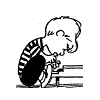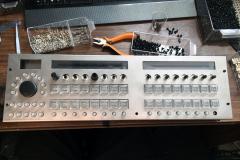-
Posts
15,248 -
Joined
Content Type
Profiles
Forums
Blogs
Gallery
Everything posted by TK.
-
I can add this to the wish list, it isn't so difficult to implement - but I know you guys, more people will request more assignable parameters, therefore I fear that sooner or later we reach the limits of assignable parameters and then a new concept will be required which is leading to much more implementation effort at my side. :-/ Best Regards, Thorsten.
-
Happy new year! Strange that I haven't noticed this during testing (maybe too much last minute code beautification ;) Here a new version: http://www.ucapps.de/mios32/midibox_seq_v4_096_pre2.zip Best Regards, Thorsten.
-
I added a new option (13/32) which changes the ALL button behaviour. In addition I changed the behaviour of the selection buttons - this works much better for me :) o Improved selection handling for midiphy frontpanel: - if you press&hold the Bookm/Step/Track/Param/Trigger/Instr/Mute or Phrase button, and then make a selection with SEL or GP buttons, the selection button will jump back to the previous function - if you press&release these buttons without a selection, the function stays active. Example: let's say the track selection is active. Press&Hold Param button, change to a new parameter layer, then release the Param button -> the selection buttons will jump back to track selection. If it's desired to permanently control the parameter layer with the selection buttons, just press&release the Param button. o New option 13/32 allows to change the steps of the current selected view only -> http://www.ucapps.de/mios32/midibox_seq_v4_096_pre1.zip Best Regards, Thorsten.
-
I remember that I never created new sequences on the RM1x and only used the preset patterns or sequenced the synth part with Cakewalk (a "DAW" running under Windows). And then I noticed that with a simple MB64 based sequencer I was able to work out interesting sequences much faster - this motivated me to add more and more features to the firmware, with the result that I created a dedicated sequencer with optimized UI - MBSEQ V2 was born: http://www.ucapps.de/midibox_seq_v2.html Best Regards, Thorsten.
-
(need some time to think about the right connections) Best Regards, Thorsten.
-
Very good, you managed to finalize no. #3 :) Best Regards, Thorsten.
-
Hurray! :) Best Regards, Thorsten.
-
MIDIbox SEQ started anno 2001 as an extension of MIDIbox64: http://ucapps.de/midibox64seq.html The interesting point: many basic concepts suchs as the layers and the unusual (but powerful) arpeggiator still exist today and make this device unique :) Best Regards, Thorsten.
-
@monokinetic yes it should be possible without much effort to activate the same functions for MBCV (and MBNG) - will check this the next days @latigid on an optional enter button to confirm entries is not considered in the firmware and also not so easy to implement (too many changes at too many places) - I also wouldn’t use it by myself, therefore it won’t be supported. Best Regards, Thorsten.
-
Finally v4.095 is available with a lot of christmas presents as found in the wishlist of many people :) MIDIboxSEQ V4.095 ~~~~~~~~~~~~~~~~~ o support for midiphy Frontpanel. The appr. HW configuration file can be found under hwcfg/midiphy_lh/MBSEQ_HW.V4 and hwcfg/midiphy_rh/MBSEQ_HW.V4 o introduced first "MBSEQV4+" function. MIDIbox SEQ V4+ is a special firmware variant for the STM32F4 core. It offers additional memory and/or CPU hungry functions which can't be implemented for STM32F1 or LPC17 due to resource limitations. These special functions are marked with "V4+" in future. o V4+: implemented CC layers for drum tracks. The CC numbers are statically assigned for all tracks of the session. They can be changed in the Options page (item 20/26) o trigger/layer edit views now also supported for drum tracks o reference step for pattern changes now works indpendent from reference step used for sync-to-measure o PATTERN page: pattern is switched immediately if SELECT button is pressed, regardless of the pattern change synchronisation option. o OPTIONS page: new option "Print and Modify Steps w/o changing Gate". If enabled: note values will always be print regardless if they are played or not. Changing a note value won't automatically enable the gate o OPTIONS page: new option "Print Notes with transposed value". Enabled by default (due to change in V4.093), can be optionally disabled now. o OPTIONS page: new option "Swap LED colours" (relevant for Wilba and midiphy Frontpanels) o OPTIONS page: new option "Invert Mute LEDs" o OPTIONS page: new TPD option "BPM" and "BPM with Beat": prints tempo value and optionally flashes to measure/beat o OPTIONS page: new TPD option "Logo" and "Logo with Beat": prints a 16x8 logo and optionally flashes to measure/beat There are individual logos for each session which can be edited in the MBSEQ_C.V4 file. If you don't find "TpdLogoLine" items there (because you are using an older session) just trigger the "Save" function o AOUT: MIDI Channel 9..12/13..15 now set the gate pins #1/3/5/7 as documented (previously it was #1/2/3/4 due to a code translation error) New: gate pins #2/4/6/8 are now set whenever the velocity is >100. This way the pins can be used as an accent trigger o V4+ AOUT: support for AOUT channel calibration. In the CV configuration menu, turn GP ENC #7 until 0V/1V/2V/.../Max will be visible. Calibrate the offset of the target value with ENC #8. Press GP #8 to cycle between min/0/max offset of the calibration point. Each V has a dedicated calibration value which can be configured this way, the output will be interpolated accordingly. Note that with exiting the CV configuration menu the calibration values are stored on SD Card in the MBSEQ_GC.V4 file (-> CV_Cali <cv-counting-from-0>). You could backup/set/restore the values from there if required. To reset all calibration values: delete all CV_Cali items in MBSEQ_GC.V4, store the file and enter "reset" in MIOS terminal. o Bugfix for permanently cleared notes if live recording is used after previous step recording o ProgramChange Layer: steps now disabled by default when the track is cleared o Whenever a track or parameter layer is unmuted, it will be automatically selected This option can now be disabled in the OPTIONS page (item 9/29) o new terminal command "lcd" allows to display a temporary message from on LCD from an external device via SysEx o encoder buttons can now be assigned in the MBSEQ_HW.V4 file (currently hardcoded to FAST function) o STM32F4 board: orange LED shows SD Card available, red LED any received MIDI IN, blue LED any transmitted MIDI OUT o experimental: terminal command "backup" creates a .tar file of the entire SD card. Whenever "backup" is entered, a new bak<incremented-number>.tar file will be created. This file can be downloaded from MIOS Studio (might take a lot of time!) or from a computer by plugging the SD Card into a SD Card reader. .tar files can be unpacked with "tar xfv <filename>" or with other decompression tools (might be already installed on your computer by default) o experimental (might be optional in future): show measure and pattern step position in main screen Best Regards, Thorsten.
-
@midilab you will find the script which generates LCD screens under: http://www.ucapps.de/midibox_seq/gen_mbseqv4_screens It requires "perl" and "convert", and probably only works under Posix-like systems such as Linux and MacOS @monokinetic thanks for the feedback, it has been considered in the official release :) Best Regards, Thorsten.
-
Very very cool! :) Can't wait to get more time for MIDIbox again (in some days...) to continue with my build based on Peters superb tutorial :) Will also release the firmware after some trial runs (and maybe some V4+ specific add-ons) Best Regards, Thorsten.
-
No this isn‘t supported – such mapping functions are very costly, without the NGC setup might be a bit more difficult, but I think this is an acceptable compromise. Best Reagrds, Thorsten.
-
Thank you! :) Best Regards, Thorsten.
-

Assembly test of unpainted SEQ v4+ case , left handed jogwheel
TK. commented on Hawkeye's gallery image in Members Gallery
-
Probably can be controlled with Roll and Roll2 layer: http://www.ucapps.de/mp3/midibox_seq/mbseqv3_gl_multi.mp3 Best Regards, Thorsten.
-
Hi, could you please zip your session directory and attach it to this thread? Maybe next week I will have some time to look into this. Best Regards, Thorsten.
-
You are right, it would be better to make this function optional. Please try this version: http://www.ucapps.de/mios32/midibox_seq_v4_095_pre14.zip It's switch #9/29 in the options page Best Regards, Thorsten.
-
Wow! Best Regards, Thorsten.
-
Wow! I'm impressed!!! :) Best Regards, Thorsten.
-
Development Queue overflow... %-) Your input won't get lost, but I think that I've to consolidate the ideas and request if still valid based on my proposals once I find the time to think about the implementation... @Rio: thanks! :) @beautyofdecay_ I added an experimental AOUT calibration feature: o V4+ AOUT: support for AOUT channel calibration. In the CV configuration menu, turn GP ENC #7 until 0V/1V/2V/.../Max will be visible. Calibrate the offset of the target value with ENC #8. Each V has a dedicated calibration value which can be configured this way, the output will be interpolated accordingly. Note that with exiting the CV configuration menu the calibration values are stored on SD Card in the MBSEQ_GC.V4 file (-> CV_Cali <cv-counting-from-0>). You could backup/set/restore the values from there if required. To reset all calibration values: delete all CV_Cali items in MBSEQ_GC.V4, store the file and enter "reset" in MIOS terminal. Please try this version: http://www.ucapps.de/mios32/midibox_seq_v4_095_pre13.zip Does it work at your side? Best Regards, Thorsten.
-
The MIDIbox NG application has such an interpolation routine which could be re-used for calibration purposes in MBSEQ. However, I'm a bit surprised that a SW based calibration is required. Which AOUT module are you using? And how big is the deviation compared to the ideal curve within the 1V segments? Best Regards, Thorsten.
-
The octave enumeration isn't standardized. E.g. in Logic Studio 0x18 is C0, and as far as I remember, you can configure MIDI-Ox to print the same. No need to change (or to add an option) at my side. Best Regards, Thorsten.
- 2 replies
-
- mios studio
- c-1
-
(and 2 more)
Tagged with:
-

LoopA V2 Introduction, Features & Support Thread
TK. replied to Hawkeye's topic in MIDIbox User Projects
Really well done Peter and Andy! For me it's always a great honor when people pick up the MIOS32 code basis, and make something new out of it. Especially when it's useful for myself - I definitely need one! :) Best Regards, Thorsten. -

Adding notes on muted steps (like on the Beatstep Pro)
TK. replied to FlavioB's topic in MIDIbox SEQ
A solution will be available with v4.095 (changes are already in the repository): o OPTIONS page: new option "Print and Modify Steps w/o changing Gate". If enabled: note values will always be print regardless if they are played or not. Changing a note value won't automatically enable the gate Best Regards, Thorsten.


